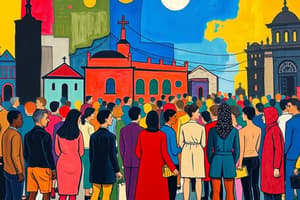Podcast
Questions and Answers
Match the type of society with its description:
Match the type of society with its description:
Hunting and Gathering Society = Relies on hunting wild animals, fishing, and gathering wild fruits for diet Pastoral Society = Characterized by domestication of animals for a stable food supply Horticultural Society = Engages in small-scale cultivation of plants and animals Agrarian/Agricultural Society = Involves large-scale cultivation and use of technology for farming
Match the society with its mobility characteristics:
Match the society with its mobility characteristics:
Hunting and Gathering Society = Nomadic lifestyle Pastoral Society = Semi-nomadic, larger populations Horticultural Society = Semi-nomadic, travel based on resource availability Agrarian/Agricultural Society = More sedentary, long-term cultivation
Match the society with its primary food source:
Match the society with its primary food source:
Hunting and Gathering Society = Wild animals, fruits, nuts Pastoral Society = Domesticated animals Horticultural Society = Cultivation of plants and vegetables Agrarian/Agricultural Society = Crops and domesticated animals
Match the society with its technological advancement:
Match the society with its technological advancement:
Match the societal class with its description:
Match the societal class with its description:
Match the societal structure with its defining characteristic:
Match the societal structure with its defining characteristic:
Match the societal development with its catalyst:
Match the societal development with its catalyst:
Match the societal workforce with their roles:
Match the societal workforce with their roles:
Match the societal transition with its defining characteristic:
Match the societal transition with its defining characteristic:
Match the societal structure with its defining characteristic:
Match the societal structure with its defining characteristic:
Match the societal development with its catalyst:
Match the societal development with its catalyst:
Match the societal workforce with their roles:
Match the societal workforce with their roles:
Match the societal transition with its defining characteristic:
Match the societal transition with its defining characteristic:
Match the society with its technological advancement:
Match the society with its technological advancement:
Flashcards are hidden until you start studying
Study Notes
Societal Classifications and Characteristics
- Match the type of society with its description:
- This implies that societies can be categorized based on their distinct features and characteristics.
Societal Mobility
- Match the society with its mobility characteristics:
- Societies can be classified based on their social mobility patterns, such as open or closed systems.
Food Sources
- Match the society with its primary food source:
- Societies can be distinguished by their primary means of acquiring food, such as hunter-gatherer, agrarian, or industrial.
Technological Advancements
- Match the society with its technological advancement:
- Societies can be categorized based on their level of technological development, such as primitive, traditional, or modern.
Societal Classes
- Match the societal class with its description:
- Societies often have distinct social classes, such as upper, middle, and lower classes, each with their own characteristics and roles.
Societal Structures
- Match the societal structure with its defining characteristic:
- Societies can be organized into different structures, such as tribal, chiefdom, or state, each with their own distinct features.
Catalysts for Development
- Match the societal development with its catalyst:
- Societal development can be triggered by various factors, such as technological innovations, environmental changes, or social movements.
Workforce Roles
- Match the societal workforce with their roles:
- Different societies have distinct workforce compositions, such as agricultural, industrial, or service-based, each with their own roles and responsibilities.
Societal Transitions
- Match the societal transition with its defining characteristic:
- Societies can undergo significant transitions, such as from traditional to modern or from rural to urban, each with their own distinct features and implications.
Studying That Suits You
Use AI to generate personalized quizzes and flashcards to suit your learning preferences.




